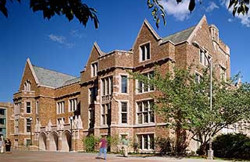For two decades, the Information School has been on what Dean Harry Bruce calls a “space odyssey.” The end of that journey is finally in sight.
The iSchool recently announced it will move to a single, prime location on the University of Washington campus: Schmitz Hall, located just across from Red Square and the Henry Art Gallery at the corner of Campus Parkway and 15th Avenue Northeast. The move is expected to be completed by summer 2018, in time for the 2018-19 school year.
“Finding a distinctive space where we can consolidate the school and accommodate our needs for learning, research and administrative spaces as well as meet our goals for identity, engagement, and collaboration has been a long journey for us and a difficult challenge for the university,” Bruce said. “I am deeply thankful for the commitment to a quality solution for the iSchool’s space needs and unwavering support from our past provost and current president, Ana Mari Cauce, and our current provost, Jerry Baldasty.”
The iSchool will occupy about 41,000 square feet of space on three floors of Schmitz Hall, a gain of 9,000 square feet over the space it will leave behind, spread among Mary Gates Hall, Bloedel Hall and the Roosevelt Commons Building.
The school’s odyssey began in 1998 when then-Dean Mike Eisenberg moved it from the basement of Suzzallo Library to the old Electrical Engineering building while the school awaited renovations at its next home.

“Mary Gates Hall wouldn't be ready until late 1999 or early 2000, but we really needed to get out of Suzzallo and establish ourselves with an identity,” Eisenberg said. “The old Electrical Engineering Building was temporary ‘surge’ space, so I got some space allocated for us there.
“To publicize our location and that we existed, we put big letters in the windows of our main classroom that faced the HUB and left the lights on all night so it was a beacon on the campus. Lots of people on campus chuckled at this – our moxie and boldness – but they admired it too!”

The school moved to the third and fourth floor of Mary Gates Hall in 2000, the same year it added the Informatics major and Ph.D. in Information Science. In 2001, the Master of Science in Information Management program began, and the iSchool's research activities increased with the addition of Ph.D. students. Space once again was quickly becoming cramped, and in 2001 the school began leasing space off campus. In 2003 the school leased additional offices in the Roosevelt Commons Building on 11th Avenue Northeast, west of the main campus.
Bruce, who became dean in 2006, began working with university leadership to find a long-term home for the iSchool. In 2007, the UW assigned Lewis Hall to the iSchool as part of its “Restore the Core” program. The building northeast of the Quad on campus was to be renovated and prepared to house the school in time for its centennial in 2011. However, the project was delayed after the 2008 recession and eventually scuttled.
Over the years, the growing school obtained a larger share of Mary Gates Hall and kept some of its research and administrative offices at the Roosevelt Commons Building, but it still was strained to accommodate its growth. In 2013, the school was offered additional space in a third location, farther south on campus at Bloedel Hall. The solution alleviated the iSchool’s immediate needs, but it was less than ideal. Teaching, research and support staff were spread among three locations.
Bruce likes to call the iSchool “a school of one,” and the move to Schmitz Hall will finally make that a physical reality.
“Having a single building where all of the operations of the school can come together in a single location is a dramatic milestone for the school,” he said.
As it moves in, the school will take steps to make the brutalist-style 1970s building feel like home.
“Renovating the building to reflect our iSchool space standards for 21st century design, technology, and quality will present some challenges,” Bruce said. “However, our community has proven that we have the creativity, innovativeness and ingenuity to create active, engaging, collaborative and high-tech spaces anywhere.
“Schmitz Hall presents us with an opportunity to create and align the location and style of our spaces to match our vision for how we want to work, learn and engage together.”